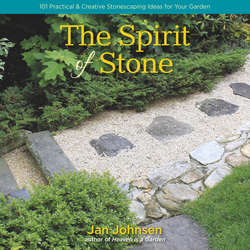Читать книгу The Spirit of Stone - Jan Johnsen - Страница 9
На сайте Литреса книга снята с продажи.
ОглавлениеIntroduction
Unresponsive, rude are the stones;Yet in them divine things lie concealed…
~ Helen Keller, “The Song of the Stone Wall”
Stone is often an overlooked player in a landscape. While we may swoon over the many shapes and colors of plants within a garden, the stone walks and walls stand silently by, perhaps unnoticed. This book shines a light on the beauty and enchantment that natural stone adds to an outdoor setting. It is a celebration of the versatility of solid, durable rock and showcases the many ways stones and stonework can be featured in the landscape.
If you have ever thought about adding this resilient natural element into your garden, then this idea book is for you. In these pages I offer illustrated design tips and practical techniques for using stone in rock gardens, walks, walls, steps – as artful accents, and much more. You will discover how many possibilities are open to you; rocks can be a still, small voice or a dramatic booming song, depending on how you use them. Bringing natural stone and stonework into your garden can elevate it and anchor it, all at the same time.
I have a soft spot for hard rock. During my four-decade career as a professional landscape designer, I have incorporated stone in a large variety of outdoor settings. It is, in my opinion, an indispensable part of a garden. My love of stone was fostered by my time living in Kyoto, Japan, as a college student years ago. I interned in a landscape architecture office and on weekends I would visit the historic Japanese gardens. I saw how natural stone and stonework was of central significance in their landscapes. I subsequently studied landscape architecture in Hawaii, where I experienced the fiery beginnings of rock by watching molten lava flowing and cooling into lava rock.
A rounded white rock sits as a sharp contrast to the orange-red foliage of a threadleaf Japanese maple tree. This stone accent enhances Nature’s autumnal beauty in a simple yet effective way.
As a young adult, I became a rock climber and my relationship with stone deepened. During ascents on New York’s Schwangunk Mountains, I would examine the vertical cliffs up close and see the cracks, fissures and protrusions of the rock as a challenge and an opportunity. I learned to place my fingers inside the crevices in the stone as a climber does, which sometimes meant strong handholds and other times a delicate fingertip grip. I later lived near Barre, Vermont, home of world famous granite quarries, and I would stand in awe as I watched giant granite slabs being hewn from the earth. Ultimately, I settled in Westchester County, New York, where rough fieldstone walls, quartz-laden boulders and classic bluestone walks and patios are found in abundance. From these diverse experiences, I have learned to cherish stone’s quiet beauty and its steadying qualities.
Here are a few examples of the many ways you can incorporate natural stone into a landscape. And don’t forget pebble mosaics, stacked stones, rock steps, stone circles and beyond!
A stone wall can indeed be a work of art. I love this particular modern style wall located in Croton-on-Hudson, New York. The larger pinkish-hued stones protrude slightly, creating interesting shadows and texture.
In The Spirit of Stone, I share my appreciation for this earthy material in the hopes that you too will include it, in some way or other, in your surroundings. Each chapter provides an overview of a different aspect of stone and stonework in the landscape. Many of the photos in this book are of landscapes I have created for others, while some are from noteworthy public and private gardens. I aim to offer you inspiration, but ideas need to be applied in achievable ways, and so I address practical installation issues, describe various stones types, offer ideas for situating stones in gardens and landscapes, and suggest plants that are perfect companions alongside rocks and stonework.
Today, you can find so many wonderful and glorious books about plants and how to use them in gardens of all types. Now, I feel, is a good time for rocks and stonework to join them on center stage. I think the Japanese-American artist and designer Isamu Noguchi summed it up nicely:
Any gardener will tell you that it is the rocks that make a garden. They call them the ‘bones’ of the garden. Plants of all sorts, however large the trees, are in a way like weeds: they come and go. But the essential quality of a garden is maintained through the solid disposition of rocks.
The Spirit of Stone celebrates the “solid disposition” of rocks and stone features in the landscape. I hope you enjoy this homage to the “bones” of a garden.
